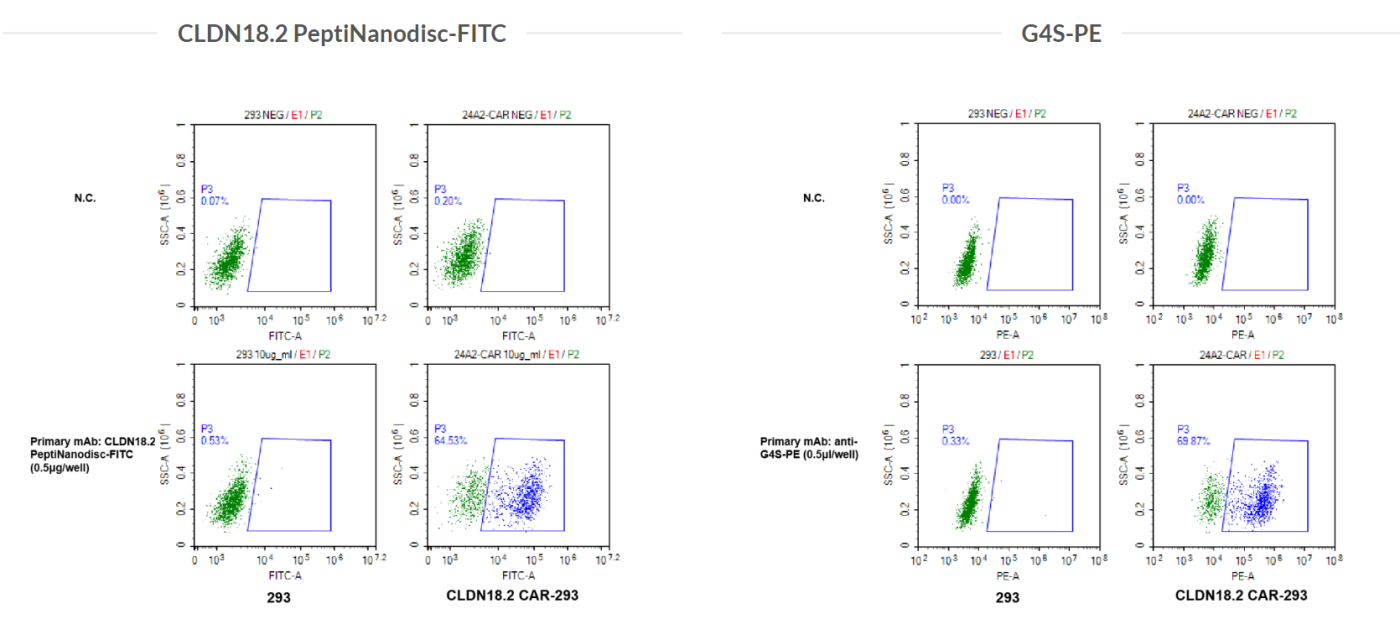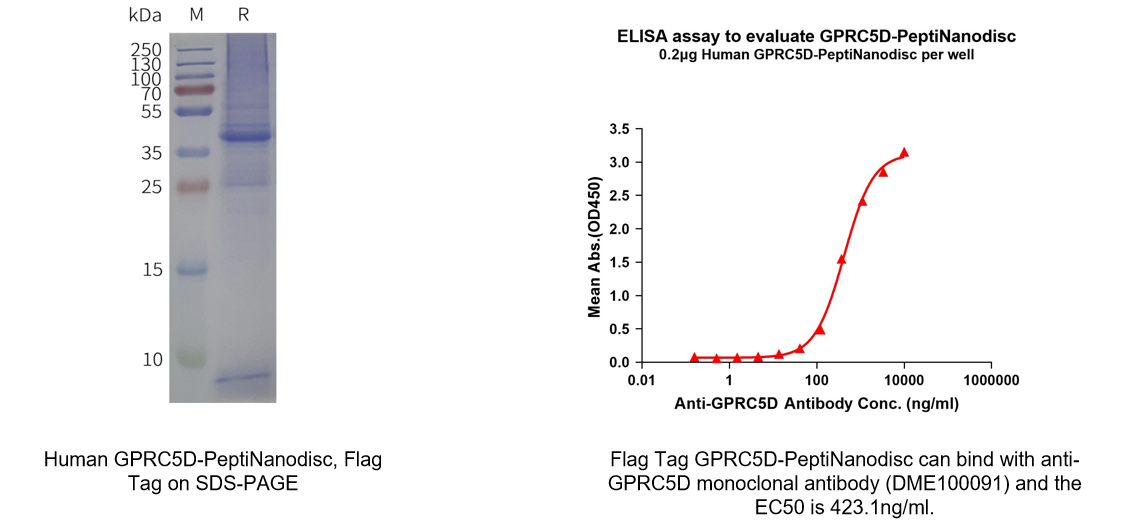1. CAR Positivity Detection
As CAR-T therapy matures, reliably measuring CAR expression on T cells has become crucial for preclinical quality control, release criteria, and efficacy prediction. The key metric, “CAR positivity rate” (%CAR⁺), reflects how well CAR binds its target antigen, typically assessed via flow cytometry or ELISA.
Common detection reagents include:
- Protein L: Binds κ light chains; broadly usable but only recognizes human Vκ I/III/IV and mouse Vκ I, missing Vκ II and many others—leading to gaps in certain CAR constructs.
- Anti‑Fab antibody: Recognizes Fab regions; offers some universality but is typically polyclonal, with high background and batch variability, compromising reliability.
- Anti‑idiotype antibody: Highly specific and sensitive—ideal for CAR-specific detection—but is rarely available commercially and often requires custom development (~6 months), limiting rapid screening.
- Target antigen protein: Capitalizes on scFv–antigen binding; specificity depends on scFv affinity and antigen quality, with risks of weak signals or false negatives. Challenges include truncated extracellular domains, unstable conformation, batch inconsistency, and cumbersome membrane expression systems.
Notably, detection accuracy hinges on antigen structural integrity. Current antigen materials—soluble extracellular fragments, cell-based systems, lipid‑reconstituted MSP nanodiscs—either lack conformational fidelity or are labor-intensive. A simplified, stable method to present full-length membrane proteins in native conformation is critically needed. Enter: PeptiNanodisc.
2. PeptiNanodisc & CAR Positivity Detection
PeptiNanodisc is a peptide‑self‑assembling membrane‑protein reconstitution platform. Two amphipathic α‑helices wrap around the target membrane protein, forming a nanodisc—without lipids or scaffold proteins. It stably reconstructs full-length membrane proteins in native conformation, ideal for CAR‑T detection studies.
2.1 What is PeptiNanodisc?
Specially designed peptide chains encapsulate the protein’s hydrophobic region, similar to a “peptide disc,” protecting it in aqueous solution. Lipids and detergents are unnecessary. It serves as a universal scaffold for diverse membrane proteins and permits direct application in cell-based assays.

Fig 1. Assembly of PeptiNanodisc.
2.2 Advantages of PeptiNanodisc
2.2.1 Accurate conformational presentation
Reconstitutes full-length, native-like membrane proteins (including transmembrane domains), preserving 3D spatial relationships—mirroring natural tumor cell contexts. This increases CAR affinity and specificity, reducing false negatives.

2.2.2 High stability and reproducibility
Avoids aggregation/denaturation typical of fusion proteins. PeptiNanodisc shows thermal resilience and structural consistency under various conditions (37 °C incubation, 4 °C storage, freeze–thaw). Without lipid background, Fc regions, or nonspecific tags, background binding is minimized, enhancing signal clarity in flow cytometry and ELISA.
2.2.3 High-throughput compatibility
Supports multiple tags (Strep, FLAG) and labels (fluorescent, biotin), enabling use in:
Flow cytometry: antigen-fluorophore to detect CAR⁺ cells.
ELISA: antigen-coated plates to assess CAR-antigen binding.
Its solubility and standardized purification make it suitable for large-scale and automated platforms.
2.2.4 Batch consistency and synthesis efficiency
Synthesized peptides ensure clear provenance and structural stability. No dependence on cellular systems
reduces variability—ideal for CAR‑T release testing, multicenter trials, and early-stage target screening.
PeptiNanodisc addresses the core question: how to present the authentic antigen for CAR detection? It improves detection precision and supports CAR product quality control and structural optimization.
3. Case Studies from DIMA BIOTECH
3.1 CAR positivity detection
① Unlabeled: GPRC5D PeptiNanodisc (FLP400011) matched performance of G4S-PE protein in flow cytometry for GPRC5D CAR cells.

The results showed that GPRC5D PeptiNanodisc (FLP400011) performed comparably to the G4S-PE method in detecting GPRC5D CAR positivity.
② Fluorescent-labeled: FITC‑labeled CLDN18.2 PeptiNanodisc replicated results of G4S-PE for CLDN18.2 CAR cells—without need for a secondary antibody.

The results showed that FITC-labeled CLDN18.2 PeptiNanodisc achieved comparable detection of CLDN18.2 CAR positivity to the G4S-PE method, while eliminating the need for a fluorescent secondary antibody, making the procedure more convenient.
3.2 SDS-PAGE & ELISA Validation
SDS-PAGE and ELISA analyses confirmed that the PeptiNanodisc protein exhibits high purity and strong antibody binding activity.

3.3 Lyophilization and Storage Stability Testing
PeptiNanodisc was evaluated under various conditions using ELISA and SDS-PAGE, and the results demonstrated good stability and binding activity.

ELISA was used to assess the binding activity between GPRC5D PeptiNanodisc and GPRC5D antibody in both liquid and lyophilized forms (left);
ELISA analysis of GPRC5D PeptiNanodisc stored at -20°C, and at 37°C for 24 h, 48 h, and 72 h, respectively, to evaluate binding activity with GPRC5D antibody (center);
SDS-PAGE analysis of GPRC5D PeptiNanodisc under various conditions: liquid state at -80°C, lyophilized powder at -20°C, and lyophilized powder stored at 37°C for 24 h, 48 h, and 72 h (right).
- PeptiNanodisc product list
| Product Cat.No. | Product Name |
| FLP400011 | Human GPRC5D full length protein-PeptiNanodisc |
| FLP420008 | Human CLDN6-Strep full length protein-PeptiNanodisc |
| FLP420014 | Human CLDN18.2-Strep full length protein-PeptiNanodisc |
